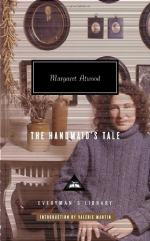|
This section contains 4,803 words (approx. 17 pages at 300 words per page) |

|
SOURCE: “The Calculus of Love and Nightmare: The Handmaid's Tale and the Dystopian Tradition,” in Critique: Studies in Contemporary Fiction, Vol. 38, No. 2, Winter, 1997, pp. 83-95.
In the following essay, Feuer discusses gender, essentialism, and ambiguity in The Handmaid's Tale, noting parallels with George Orwell's 1984. According to Feuer, Atwood's ironic presentation of a totalitarian “woman's culture” reflects schisms in contemporary feminist theory.
Reviewers of Margaret Atwood's The Handmaid's Tale invariably hailed it as a “feminist 1984,” and, like many handy tags, this one conceals a partial truth. A closer look, however, reveals not only the similarities between the two novels’ totalitarian societies, but the ways in which Atwood's work goes beyond Orwell's, in matters of style that become matters of substance as well as in the feminist debate over “essentialism” that Atwood brings to the dystopian tradition. The novel transforms that tradition stylistically as well as thematically as Atwood, aware...
|
This section contains 4,803 words (approx. 17 pages at 300 words per page) |

|


